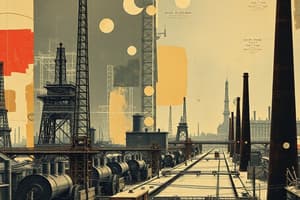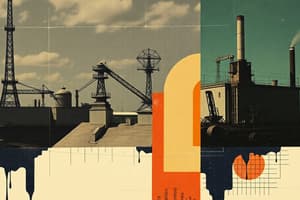Podcast
Questions and Answers
What is the growing rate of the industrial sector per annum during the Industrial Revolution?
What is the growing rate of the industrial sector per annum during the Industrial Revolution?
- 1% per annum
- 5% per annum
- 4% per annum (correct)
- 2% per annum
How long will it take for the industrial and agricultural sectors to be of equal size?
How long will it take for the industrial and agricultural sectors to be of equal size?
- 100 years
- 60 years
- 74 years (correct)
- 50 years
What is implied by the law of diminishing marginal returns?
What is implied by the law of diminishing marginal returns?
- Marginal product of labor increases consistently.
- Each additional unit of labor has no effect on output.
- Output will decrease as more labor is added.
- Output increases but the marginal increment decreases. (correct)
Which factor has become less important in the economy during the Industrial Revolution?
Which factor has become less important in the economy during the Industrial Revolution?
What are the three parts of technological development mentioned in the content?
What are the three parts of technological development mentioned in the content?
What characterizes micro-improvements in technology?
What characterizes micro-improvements in technology?
Why are macro-inventions more likely to develop in high-wage economies?
Why are macro-inventions more likely to develop in high-wage economies?
What is the expected outcome as technology becomes cheaper over time?
What is the expected outcome as technology becomes cheaper over time?
What is described as the 'elevator of growth' in the world economy?
What is described as the 'elevator of growth' in the world economy?
What drives the demand for labor-saving technology in high-wage economies?
What drives the demand for labor-saving technology in high-wage economies?
What does the law of diminishing marginal returns imply about the relationship between production and factors of production?
What does the law of diminishing marginal returns imply about the relationship between production and factors of production?
Which of the following best describes economies of scale?
Which of the following best describes economies of scale?
What is the significance of GDP per capita in economic analysis?
What is the significance of GDP per capita in economic analysis?
According to the Fundamental Equation of Growth, what does gA represent?
According to the Fundamental Equation of Growth, what does gA represent?
Why is total factor productivity (gA) often considered a 'measure of our ignorance'?
Why is total factor productivity (gA) often considered a 'measure of our ignorance'?
What significant change occurred around 1750 that impacted economic growth?
What significant change occurred around 1750 that impacted economic growth?
What does GDP per Capita measure?
What does GDP per Capita measure?
Which region experienced significant wealth growth around 1820?
Which region experienced significant wealth growth around 1820?
Which is an example of a change in global economic standings observed in the Reversal of Fortune?
Which is an example of a change in global economic standings observed in the Reversal of Fortune?
What characterized the world economy in the year 1000?
What characterized the world economy in the year 1000?
What effect did the Industrial Revolution have on manufacturing distribution?
What effect did the Industrial Revolution have on manufacturing distribution?
What significant result did the Agricultural Revolution have on societies?
What significant result did the Agricultural Revolution have on societies?
What was a notable feature of the world's economic state in 1500?
What was a notable feature of the world's economic state in 1500?
What is a characteristic of firms in a competitive market regarding pricing?
What is a characteristic of firms in a competitive market regarding pricing?
What determines the minimum cost for each level of production?
What determines the minimum cost for each level of production?
Which of the following describes increasing returns to scale?
Which of the following describes increasing returns to scale?
What is included in fixed costs for a firm?
What is included in fixed costs for a firm?
How do variable costs change with production levels?
How do variable costs change with production levels?
Which of the following is true about the cost function?
Which of the following is true about the cost function?
What does the concept of 'returns to scale' refer to?
What does the concept of 'returns to scale' refer to?
What does the tangent point between isocost and isoquant represent?
What does the tangent point between isocost and isoquant represent?
What relationship indicates the profit-maximizing output for price-taking firms?
What relationship indicates the profit-maximizing output for price-taking firms?
What remains constant for price-taking firms as they sell additional units?
What remains constant for price-taking firms as they sell additional units?
What is implied by the concept of market equilibrium?
What is implied by the concept of market equilibrium?
Which of the following is NOT a factor that can cause demand shocks?
Which of the following is NOT a factor that can cause demand shocks?
What does the Law of One Price state?
What does the Law of One Price state?
Which outcome best describes a market in equilibrium?
Which outcome best describes a market in equilibrium?
How do supply shocks affect market outcomes?
How do supply shocks affect market outcomes?
In the context of economic production, which of these aspects do we focus on?
In the context of economic production, which of these aspects do we focus on?
Flashcards
Industrial Revolution
Industrial Revolution
A period of rapid economic growth starting around 1750, characterized by new technologies, inventions, and industrial advancements.
Gross Domestic Product (GDP)
Gross Domestic Product (GDP)
The total value of goods and services produced in an economy within a specific time period (usually a year).
GDP per Capita
GDP per Capita
A measure of a country's economic output per person. It helps to compare living standards across different countries.
Agricultural Revolution
Agricultural Revolution
Signup and view all the flashcards
Reversal of Fortune
Reversal of Fortune
Signup and view all the flashcards
Globalization
Globalization
Signup and view all the flashcards
Economic Development
Economic Development
Signup and view all the flashcards
Hockey Stick of Growth
Hockey Stick of Growth
Signup and view all the flashcards
Law of Diminishing Marginal Returns
Law of Diminishing Marginal Returns
Signup and view all the flashcards
Malthusian Trap
Malthusian Trap
Signup and view all the flashcards
Innovation
Innovation
Signup and view all the flashcards
Diffusion
Diffusion
Signup and view all the flashcards
Marginal Return
Marginal Return
Signup and view all the flashcards
Economies of Scale
Economies of Scale
Signup and view all the flashcards
Competitive Market (free market)
Competitive Market (free market)
Signup and view all the flashcards
Fundamental Equation of Growth
Fundamental Equation of Growth
Signup and view all the flashcards
Micro-improvements
Micro-improvements
Signup and view all the flashcards
Induced Innovation
Induced Innovation
Signup and view all the flashcards
Elevator of Growth
Elevator of Growth
Signup and view all the flashcards
Technology Diffusion
Technology Diffusion
Signup and view all the flashcards
High-Wage Country vs. Low-Wage Country: Technology Adoption
High-Wage Country vs. Low-Wage Country: Technology Adoption
Signup and view all the flashcards
Price-taker
Price-taker
Signup and view all the flashcards
Market power
Market power
Signup and view all the flashcards
Marginal Cost
Marginal Cost
Signup and view all the flashcards
Average Cost
Average Cost
Signup and view all the flashcards
Fixed Costs
Fixed Costs
Signup and view all the flashcards
Variable Costs
Variable Costs
Signup and view all the flashcards
Production Function
Production Function
Signup and view all the flashcards
Isoquant
Isoquant
Signup and view all the flashcards
Competitive Market
Competitive Market
Signup and view all the flashcards
Market Equilibrium
Market Equilibrium
Signup and view all the flashcards
Marginal Revenue (MR)
Marginal Revenue (MR)
Signup and view all the flashcards
Marginal Cost (MC)
Marginal Cost (MC)
Signup and view all the flashcards
Profit-Maximizing Output
Profit-Maximizing Output
Signup and view all the flashcards
Demand Shock
Demand Shock
Signup and view all the flashcards
Supply Shock
Supply Shock
Signup and view all the flashcards
Law of One Price
Law of One Price
Signup and view all the flashcards
Study Notes
No specific topic provided. Please provide the text or questions for which you would like me to generate study notes.
Studying That Suits You
Use AI to generate personalized quizzes and flashcards to suit your learning preferences.
Related Documents
Description
This quiz explores key economic concepts and phenomena that emerged during the Industrial Revolution. Questions range from the growing rate of the industrial sector to the implications of technological developments and the law of diminishing marginal returns. Test your understanding of how these concepts shaped the economy.



